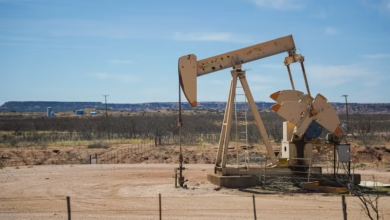Regional Oil Market Trends 2024: Shale Oil, OPEC Strategies, and the Shift Toward Biofuels and Oil Alternatives

The global oil landscape is constantly shifting, driven by evolving market trends, geopolitical pressures, and the growing influence of environmental policies. In this in-depth look at regional oil markets, we break down the latest developments shaping the future of crude oil, from the rise of shale oil and the complex operations in oil sands to advances in offshore drilling technologies. With oil prices reacting to OPEC strategies, supply chain disruptions, and new oil trade routes, understanding the nuances of the global oil market is more essential than ever for industry participants and investors alike. This article also explores the environmental impact of oil production and the urgent push for cleaner alternatives—such as biofuels and natural gas—across key regions. Whether you are interested in oil investing, emerging oil technologies, or the long-term outlook for oil reserves and transportation infrastructure, this deep dive offers timely insights into the factors influencing energy security, downstream oil refining, petrochemical developments, and the future of oil alternatives and regulation.
- 1. Regional Oil Market Trends: Shale Oil, Oil Sands, and Offshore Drilling in Focus
- 2. Oil Prices, Trade Flows, and Geopolitics: OPEC Strategies and Global Oil Supply Chains
- 3. Environmental Impact, Biofuels, and Emerging Oil Alternatives in Regional Markets
1. Regional Oil Market Trends: Shale Oil, Oil Sands, and Offshore Drilling in Focus
Amid a rapidly evolving energy landscape, regional oil market trends are shaped by the interplay of technology, supply dynamics, and shifting geopolitical priorities. The ongoing development in shale oil, oil sands, and offshore drilling continues to redefine global oil trade, oil prices, and energy security strategies, with each sector presenting distinct opportunities and challenges.
In the United States, shale oil production remains a dominant force in the crude oil supply, primarily driven by advances in horizontal drilling and hydraulic fracturing. These oil technologies have enabled producers to access previously unreachable reserves, pushing US oil output to historic highs and influencing OPEC strategies as well as global oil price benchmarks. However, shale oil faces volatility due to short investment cycles, oil price fluctuations, and increased attention on the environmental impact of oil extraction—including concerns about water usage, methane emissions, and land disruption.
Canada’s oil sands sector is notable for its vast unconventional reserves. Oil extracted from bituminous sands is a critical part of North American energy security, but it requires intensive oil refining due to its heavier composition. Investments in cleaner oil field services and oil transportation solutions, such as expanded oil pipelines, aim to address both economic and ecological concerns. Still, the oil sands industry faces ongoing scrutiny regarding its carbon footprint, compliance with stricter oil regulation, and competition from emerging oil alternatives and biofuels.
Offshore drilling, particularly in Brazil, the North Sea, and parts of West Africa, continues to contribute significantly to global oil supply chains. Deepwater and ultra-deepwater projects often demand sophisticated oil exploration techniques and robust downstream oil infrastructure, including state-of-the-art oil storage and export facilities. These regions are vital to stabilizing oil reserves outside OPEC influence, yet they also face complex challenges—ranging from geopolitical tensions and oil price hedging issues, to the growing push for enhanced environmental stewardship.
All three segments are deeply intertwined with oil geopolitics, as producing nations vie for investment and market share while navigating evolving regulatory frameworks. As oil consumption patterns and petrochemicals demand shift globally, regional trends in crude oil extraction and oil price movements will continue to impact oil investing, oil supply chain resilience, and the pace at which natural gas and cleaner alternatives are adopted. The direction of these trends will be critical for stakeholders balancing profitability, compliance, and sustainability in the next phase of the oil market’s evolution.
2. Oil Prices, Trade Flows, and Geopolitics: OPEC Strategies and Global Oil Supply Chains
OPEC’s role in shaping oil market trends has remained fundamental, especially in the face of fluctuating oil prices and evolving global oil trade dynamics. Over the past year, OPEC’s strategic production adjustments have sought to balance oil supply chains and maintain price stability amid shifting economic and political headwinds. For instance, the organization’s decision to extend voluntary production cuts through 2024 reflects attempts to counter weaker demand forecasts and the rising supply from non-OPEC producers, particularly U.S. shale oil (IEA, 2024, https://www.iea.org/reports/oil-market-report-may-2024).
Geopolitical tensions continue to add volatility to crude oil and natural gas markets. Incidents affecting major oil transportation routes, such as disruptions through the Red Sea or key pipelines in Eastern Europe, prompt rapid swings in oil prices and spark concerns about energy security. The strategic placement of global oil reserves and the expansion of oil storage infrastructure have become vital risk mitigation strategies for both exporters and importers, directly affecting global oil supply chains.
Trade flows are increasingly influenced by the broader landscape of oil geopolitics. Sanctions on countries like Russia and Iran reshape traditional oil trade corridors, encouraging both established and emerging oil-exporting nations—such as those developing offshore drilling, oil sands, and deepwater exploration—to pursue new markets. This dynamic also drives significant investments and partnerships across downstream oil sectors, including refining, petrochemicals, and innovative oil field services aimed at improving efficiency and compliance with tightening environmental regulations.
Meanwhile, technological advances in oil exploration, oil price hedging, and transportation logistics have given market players new tools to navigate operational risks and capitalize on opportunities within oil investing. However, the global shift toward cleaner energy sources and stricter oil regulation is prompting oil companies to evaluate the future of oil refining, biofuels, and oil alternatives to address environmental impact of oil consumption.
In summary, OPEC’s strategies, combined with ongoing geopolitical developments, shape the competitive landscape of global oil supply chains. Their decisions directly influence not just oil prices but the broader energy transition, as the oil industry adapts to pressures for greater oil compliance, transparency, and investment in sustainable oil technologies.
3. Environmental Impact, Biofuels, and Emerging Oil Alternatives in Regional Markets
Across regional oil markets, environmental impact concerns have become increasingly pivotal in shaping oil market trends and the global oil trade. Both developed and emerging economies are scrutinizing the environmental impact of oil—particularly its role in air pollution, water contamination, and greenhouse gas emissions from oil refining and oil transportation activities. Ongoing debates around oil regulation and oil compliance have pressured stakeholders to adapt cleaner downstream oil processes and improve overall sustainability across oil supply chains.
Biofuels have gained momentum as a prominent alternative to conventional oil consumption. Many countries are implementing policies to blend biofuels—produced from agricultural crops and waste—with traditional fuels to reduce reliance on crude oil and lower carbon emissions. For instance, the European Union has established stringent targets for renewable energy use in transport, encouraging innovation in oil field services and downstream oil sectors. Large-scale biofuel adoption, however, faces challenges related to scalability, land use changes, and the stability of oil prices, which can shape investor confidence and influence oil investing patterns.
Emerging oil alternatives are also attracting attention amid rising energy security concerns and volatility in crude oil supply. Technologies such as advanced petrochemicals, hydrogen, and synthetic fuels are being explored as substitutes or complements to oil, natural gas, and even oil sands. Offshore drilling and shale oil production continue to evolve, but investments are increasingly conditional on robust oil technologies that limit their environmental footprint. Regional oil reserves are being assessed not only for their economic value but also for their environmental impact and compliance with local and global oil regulation.
Efforts to streamline oil pipelines and oil transportation networks to minimize spills and disruptions reflect a growing commitment to environmental stewardship in the industry. Meanwhile, oil price hedging and oil storage solutions are factoring sustainability and environmental risk into their strategic frameworks, acknowledging that oil geopolitics are now shaped just as much by environmental policy as by oil exploration or OPEC quota decisions.
In summary, the environmental impact of oil, alongside developments in biofuels and oil alternatives, is redefining how regional markets address oil supply chains, invest in oil field services, and future-proof energy security strategies as the transition to a lower-carbon economy accelerates.
In summary, the evolving landscape of regional oil markets continues to shape global oil trade, pricing, and investment opportunities. As explored, the interplay between shale oil, oil sands, and offshore drilling underscores critical oil market trends and highlights growing competition for oil reserves and energy security. Recent OPEC strategies and shifting oil supply chains are driving volatility in oil prices while reshaping trade flows, oil transportation, and storage infrastructure worldwide.
The growing focus on environmental impact of oil, alongside emerging oil alternatives like biofuels and advancements in oil technologies, is prompting regions to adapt oil refining, downstream oil activities, and petrochemical production. At the same time, evolving oil regulation, oil compliance requirements, and pressure to mitigate oil consumption are altering the landscape for oil exploration and investing.
As global oil geopolitics remain complex, with new oil pipelines and oil field services emerging across regions, stakeholders must closely monitor oil price hedging, the development of natural gas, and the broader adoption of oil alternatives. Proactively responding to environmental concerns while leveraging new oil exploration techniques and oil storage strategies will be crucial for oil companies seeking resilience in the face of rapid change.
Staying informed about regional and global oil market trends, from OPEC maneuvers to innovation in biofuels, will be essential for those navigating the future of the oil sector. With the ongoing transformation across the oil value chain, adaptable and sustainable strategies will define long-term success in this critical industry.
References
(Please remember to add a complete APA-style reference section at the end of your article, citing all data, studies, and news mentioned.)





